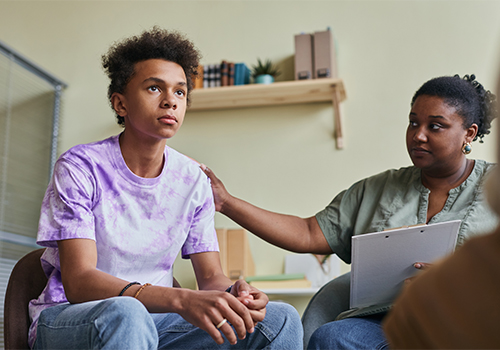Teen therapy provides a safe and productive space for adolescents to work through challenges while gaining support from their peers. Group therapy, in particular, is a vital component of treatment at Foothills at Red Oak Recovery®. It offers the teen boys we help the chance to connect, learn, and grow together. Whether your son is struggling with substance use, anxiety, or other behavioral concerns, teen group therapy can play an essential role in their path to healing.

How group therapy works for adolescents
Group therapy for teens follows a structured approach so that sessions are both effective and meaningful. Typically, sessions include 6–10 participants and are guided by a trained therapist. Each group is tailored to meet the participants’ needs, with activities and discussions focused on targeted goals.
At Foothills, our licensed therapists set ground rules with our teen boys early on to create a supportive and respectful environment. They might include guidelines around confidentiality, active listening, and mutual respect among group members. Rules are in place to help teens find a sense of safety where they feel comfortable sharing their thoughts and emotions, that way they can make more progress during treatment.
Benefits of group therapy
Teens in group therapy experience benefits both during sessions and long after they end. First and foremost, these sessions provide peer support, which is invaluable during adolescence. Seeing that they are not alone in their struggles can be incredibly healing for many teens.
Group therapy also promotes social skill development. Through discussions and interactions, teens practice communication, empathy, and cooperation, which become even more important as they navigate the transition to adulthood. The group dynamic also encourages to hold one another accountable. Peers motivate each other to stay on track with their goals and offer encouragement during challenging times.
When paired with individual counseling, group therapy offers a unique layer of reinforcement. Teens not only hear from a licensed therapist but also gain fresh perspectives from their peers on similar journeys.
Common group types in teen therapy
Foothills at Red Oak Recovery® uses a variety of group methods to address the unique needs of adolescent boys struggling with substance use and their mental health. Common types of group sessions include:
- Cognitive-behavioral therapy (CBT): Focused on identifying negative thought patterns and developing healthier behaviors.
- Dialectical behavior therapy (DBT): Offering skills-based support to manage emotions, handle stress, and improve relationships.
- Psychoeducation groups: Teaching teens about mental health and substance use to build awareness and coping strategies.
- Skills groups: These sessions help teens learn tangible techniques, such as mindfulness, time management, or dealing with peer pressure.
Each type of group therapy serves a specific purpose, giving your teen access to the help most relevant to their needs and situation.
Overcoming group-related anxieties
It’s normal for teens to feel nervous about joining their first group therapy session. Many worry about speaking up in front of strangers or being judged. However, these concerns often fade once they see how supportive therapists and their peers are.
Licensed therapists at Foothills guide teens through this initial discomfort by allowing them to ease into discussions at their own pace, gradually encouraging them to open up. An inclusive and respectful environment means every participant feels valued.
Parents can also help by normalizing group therapy and helping their teen recognize how much better they can feel by expressing what’s on their mind. Remind them that the goal is progress, not perfection.
Measuring progress in a group setting
Progress in group therapy can be more dynamic than in individual sessions. Clinicians will monitor how well teens are engaging, sharing, and applying new skills outside of therapy. For example, they may check in with parents to talk about what improvements in their teen’s mood, communication, or stress management they’ve noticed.
The group setting also allows teens to see their own growth in contrast to where they started. Hearing feedback from peers or reflecting on personal contributions can reinforce their progress. Progress is measured not only by clinical milestones but also by the sense of belonging and self-awareness teens gain from the group.
How group therapy complements individual counseling
At Foothills in North Carolina, we know that adolescent group counseling is most effective when combined with individual therapy. During one-on-one sessions, teens work through more personal, sensitive issues, like processing trauma, in-depth. Then, when they attend group therapy, they can use what they learned to talk about what new coping skills they’re trying.
This combination helps create a well-rounded treatment plan. For example, a teen who sets a goal in individual therapy might discuss challenges and successes with their group. The group becomes a source of motivation, while the individual therapist provides customized guidance.
Why choose teen group therapy in North Carolina?
Foothills at Red Oak Recovery® offers a compassionate and inclusive environment for teens struggling with mental health and behavioral challenges. Our team of master’s-level clinicians provides personalized, evidence-based care tailored to each teen’s needs.
If your son could benefit from connecting with peers who truly understand their struggles, consider the teen group therapy benefits we can provide. Foothills at Red Oak Recovery® helps teen boys build the skills and confidence they need to succeed.
Reach out today to learn more about our range of therapies, including group and individual counseling. Call us today at 828.519.5047 or use our online contact form. We’re here to support your teen every step of the way.
